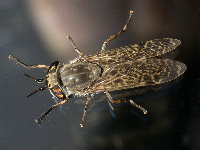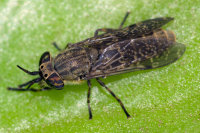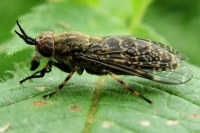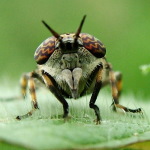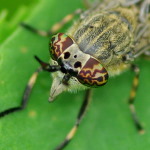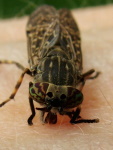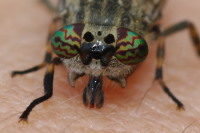Phylum Arthropoda (Arthropods) ➔ Subphylum Hexapoda (Hexapods) ➔ Class Insecta (Insects) ➔ Order Diptera (True flies) ➔ Family Tabanidae (Clegs, deer flies, horse flies)
Haematopota pluvialis (Linnaeus, 1758)
Regenbremse Common Horse Fly
Synonyms and other combinations:
Chrysozona minima Ghidini, 1935 | Haematopota ioffi Olsufjev, 1972 | Haematopota marginula Meigen, 1820 | Haematopota ocellata Meigen, 1820 | Haematopota pleuralis Matsumura, 1931 | Haematopota sakhalinensis Shiraki, 1918 | Haematopota tristis Bigot, 1891 | Tabanus arcticus Müller, 1764 | Tabanus equorum Fabricius, 1794 | Tabanus hyetomantis Schrank, 1803 |
Further vernacular names:
Notch-horned Cleg Fly, Common ClegClassification:
Haematopota pluvialis belongs to the subfamily Tabaninae.Distribution:
Europe, Russia, China; widespread and frequent in Europe.Habitat:
In different biotops, in humid environment, often at forest edges.Description:
The Common Horse Fly has a body length of 8 - 12 mm. Its wings are patterned and are laid together like a roof in resting position. Femora are blackish-grey.Males and females are easily distinguished by their eyes. The jaggy striped, conspicuously colorful iridescent eyes of the females are clearly separated. In the males, the eyes, appearing monochrome from above, touch each other and show a pattern only in the lower part.
Similar species:
There are some similar species in the genus.The females of Haematopota pluvialis differ from those of the similar Haematopota crassicornis by a sub-apical notch of the 1st antennal segment and by the 3rd antennal segment colored orange at the base, which is entirely black in Haematopota crassicornis.
Biology:
The adults of the Common Horse Fly Haematopota pluvialis can be found from May to October.While the males feed on nectar and plant saps, the females need an additional blood meal to produce their eggs. The females suck blood from mammals, often from cattle and horses. They can become very annoying as they also attack humans and bite painfully.
The females lay their eggs stacked in packages on the surface of moist, but not too wet, soil or at the base of grass-stems.
Larvae of Haematopota pluvialis were found in large numbers on pasture-land, preferably on undisturbed old-field-pasture. The larvae feed on dead plant material and small animals. The pupation takes place in the soil.
References, further reading, links:
- Pape T. & Thompson F.C. (eds) (2017). Systema Dipterorum (version 2.0, Jan 2011). In: Species 2000 & ITIS Catalogue of Life, 2017 Annual Checklist (Roskov Y., Abucay L., Orrell T., Nicolson D., Bailly N., Kirk P.M., Bourgoin T., DeWalt R.E., Decock W., De Wever A., Nieukerken E. van, Zarucchi J., Penev L., eds.). Digital resource at www.catalogueoflife.org/annual-checklist/2017. Species 2000: Naturalis, Leiden, the Netherlands. ISSN 2405-884X.
- E. Völlger, M. Jeremies: Bestimmungsschlüssel für mitteleuropäische Bremsen (Dipt., Tabanidae), Entomologische Nachrichten und Berichte, 29, 1985/1, 1-11.
- Stjepan Krčmar, Davorka K. Hackenberger, Branimir K. Hackenberger: Key to the horse flies fauna of Croatia (Diptera, Tabanidae); Periodicum Biologorum, Vol. 113, Suppl 2, 2011, ISSN 0031-5362.
- Michael Chinery: Pareys Buch der Insekten: über 2000 Insekten Europas, Verlag Kosmos, 2004, 326 Seiten, ISBN 3440099695, 9783440099698.
- NRH Burgess, AE Shuttleworth, KN Chetwyn: The Immature Stages of the Common Cleg Haematopota pluvialis L. (Diptera: Tabanidae) in the Field and in the Laboratory; J. roy. Army med. Cps. 1978. 124, 27-30.
- M. Mally und E. Kutzer: Zur Tabanidenfauna Österreichs und Betrachtungen zu ihrer medizinischen Bedeutung, Mitt. Österr. Ges. Tropenmed. Parasitol. 6 (1984) 97-103.
